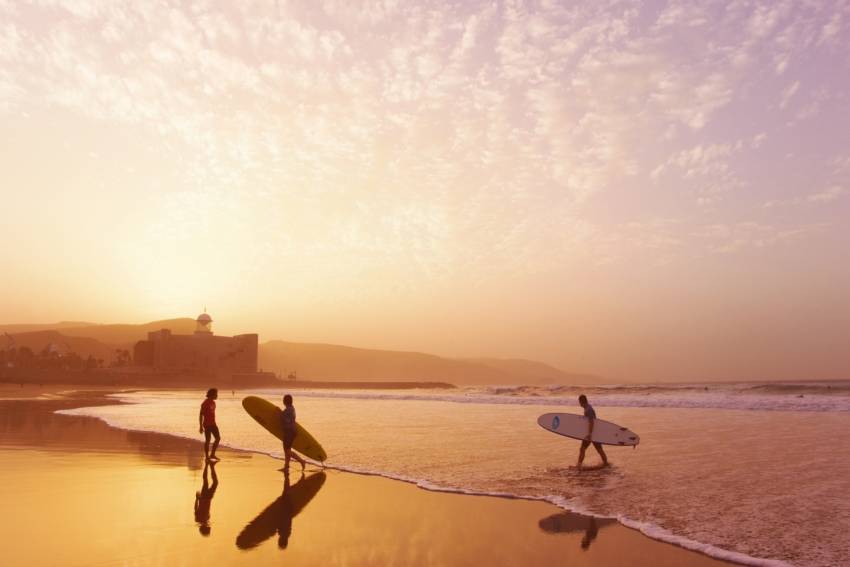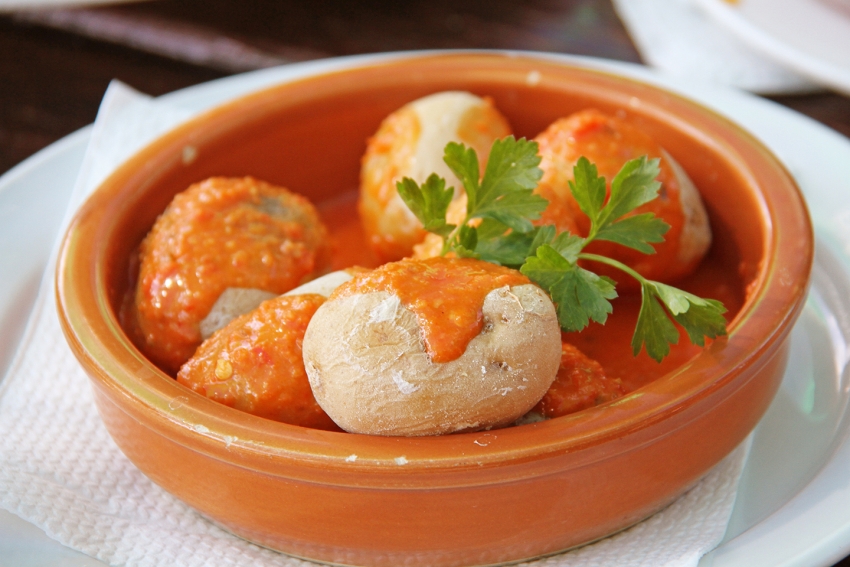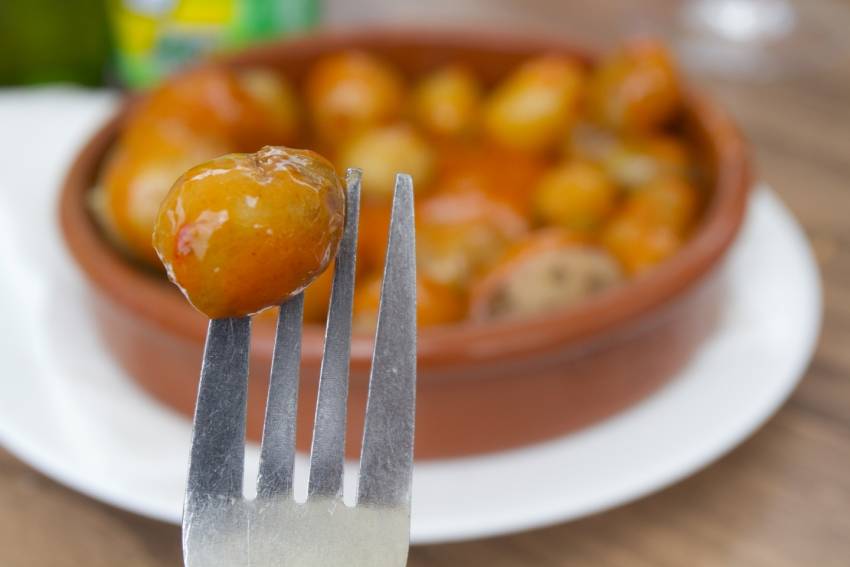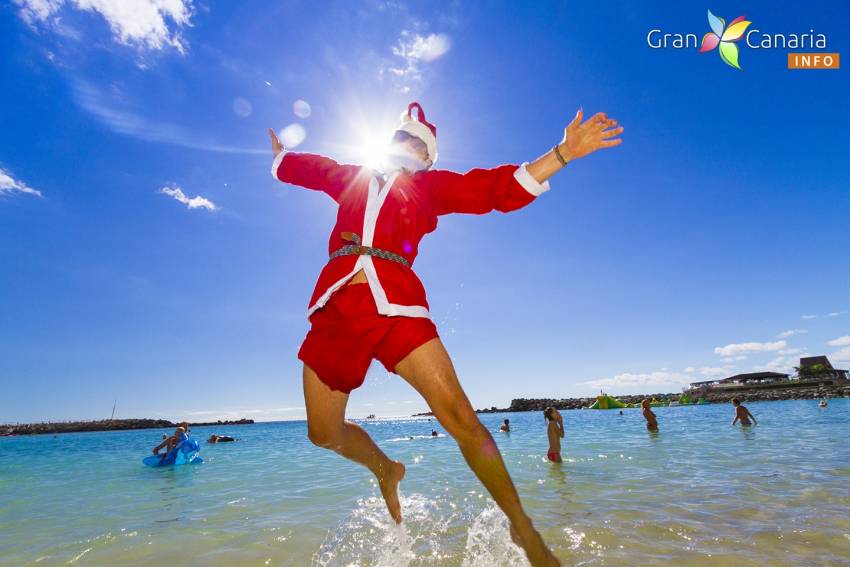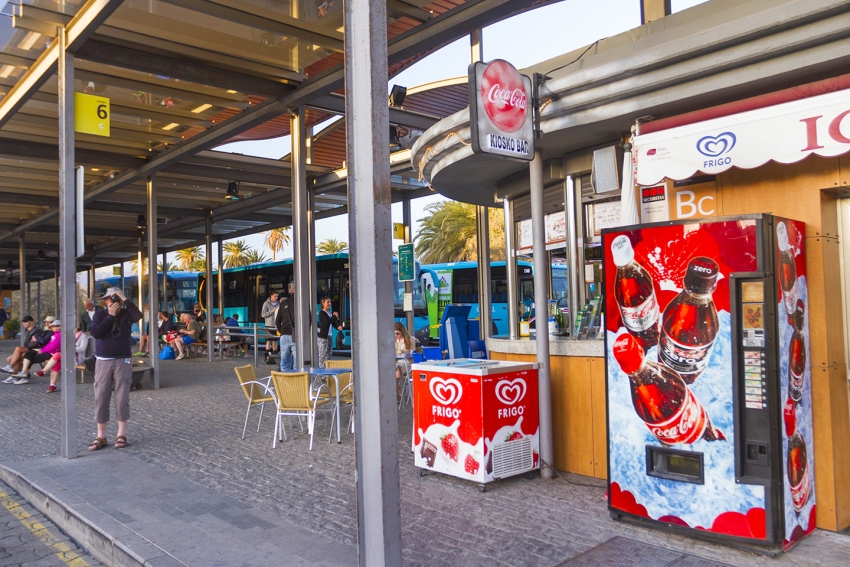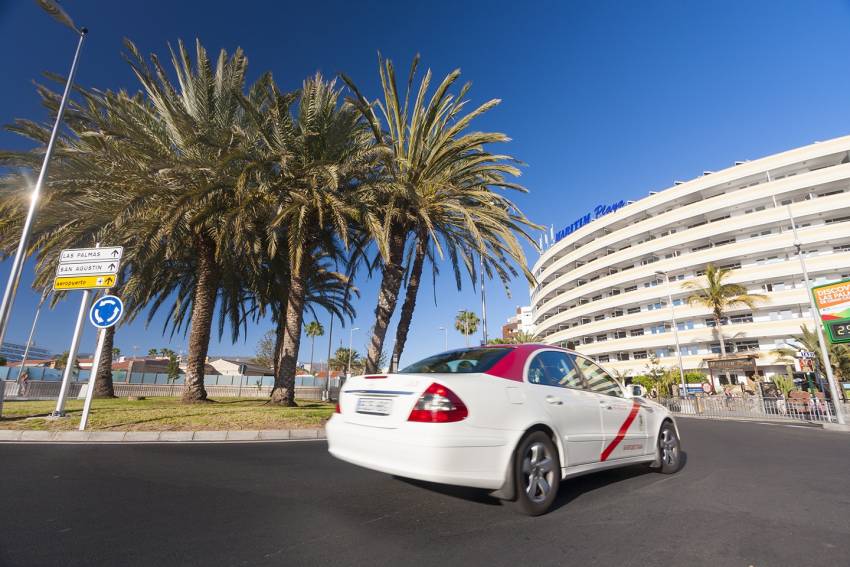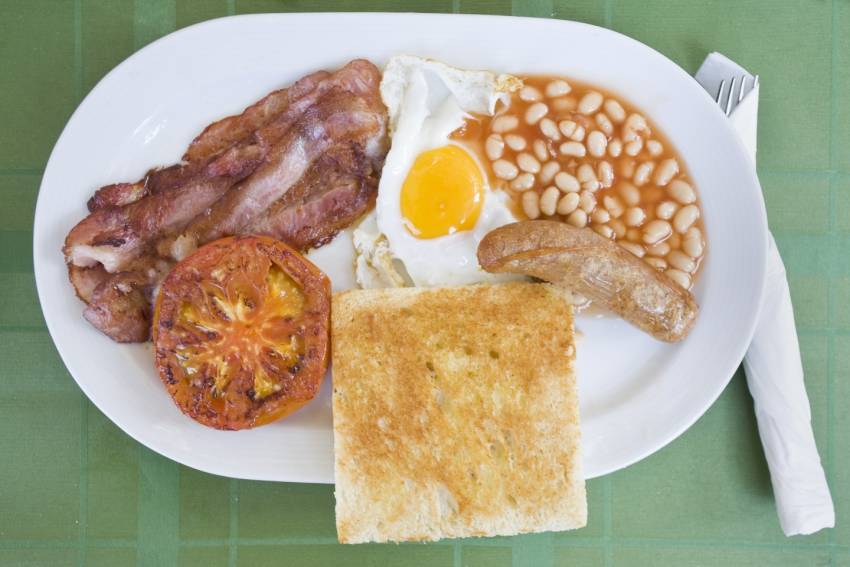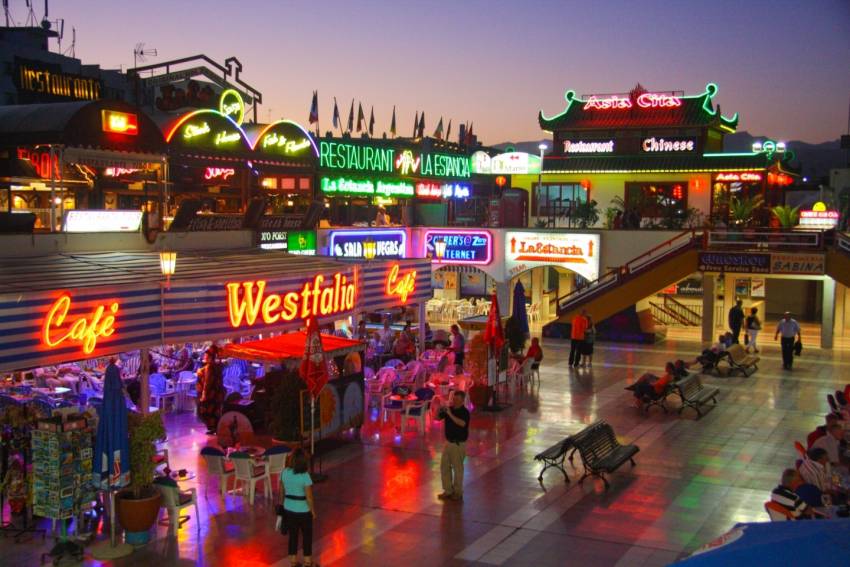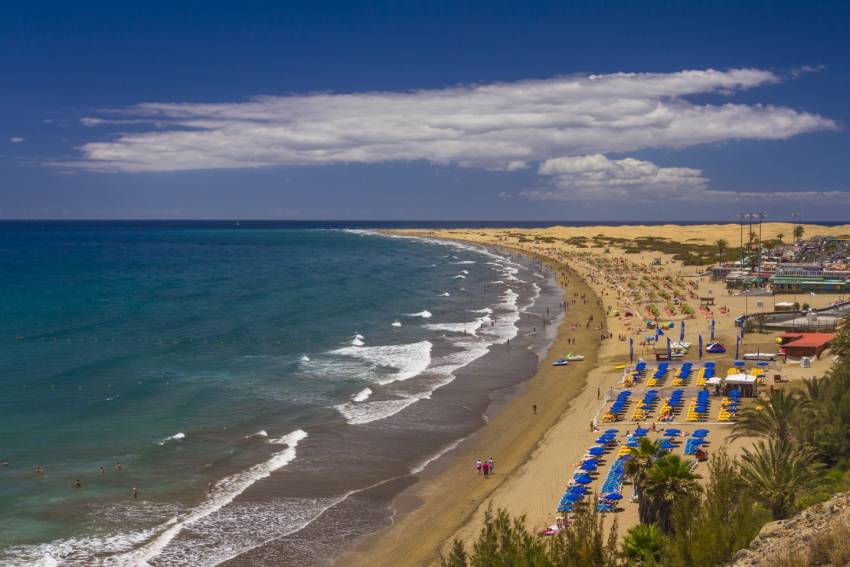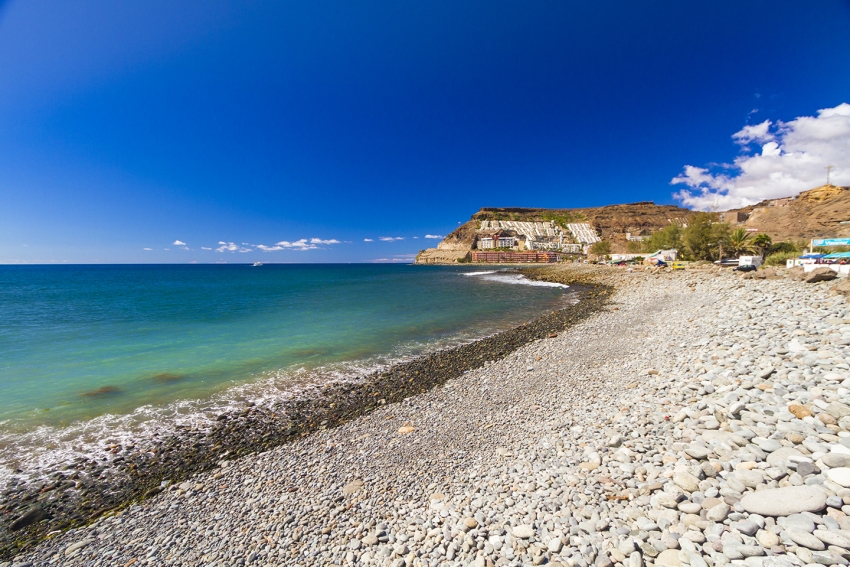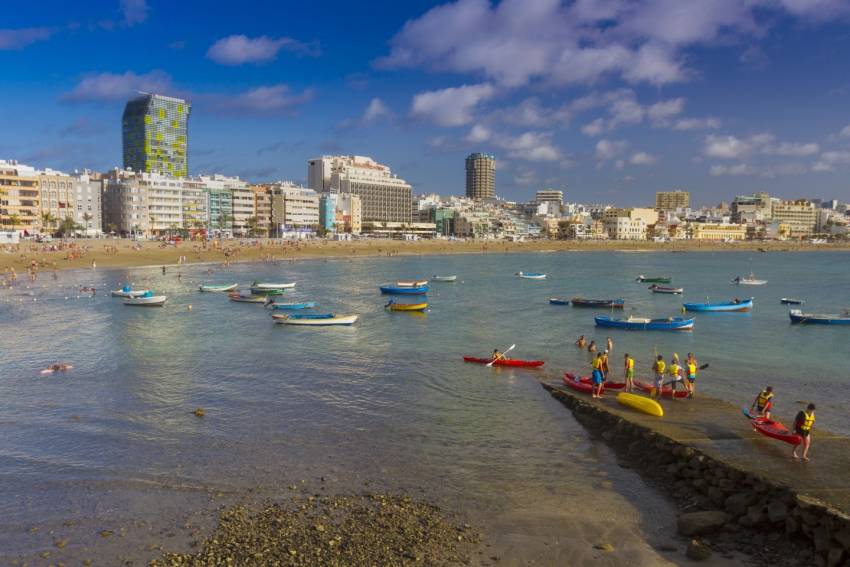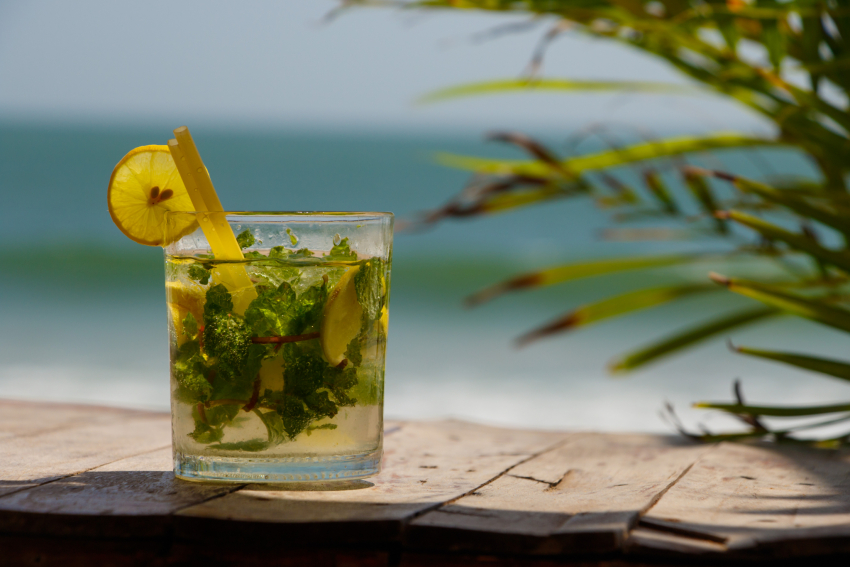Light and fluffy, golden brown, with a crust of flaky sugar and a hint of lemon: Gran Canaria's doughnuts, called donuts, are a delight.
The fantastic roads running up the Mogan, Arguineguín and Fataga Valleys used to be deserted apart from local buses and the odd hire car. Head up there nowadays and it's like you took a wrong turn and bumped into the Tour de France. Gran Canaria is firmly on the road biking map and even has its own Tour of Gran Canaria.
Las Palmas is a Spanish city with a Canarian accent and a few South American flourishes. It's the only city in Europe where salsa and coconut palms thrive alongside mojo, tapas and vino tinto.
There are two ways to see Las Palmas: Get sore feet seeing the whole place in a day and ending up with a full memnory card and that fuzzy been-there done-that feeling that fades as soon as you move on.
Or, you can do laid-back Las Palmas at its own pace: Instead of charging around take your time doing very little, very thoroughly.
Start by sitting down and drinking a proper cofee
In Las Palmas coffee is made by grown ups instead of baristas and it's all the better for it: Pure bean juice unsullied by pretension, syrups and towers of cream. It comes served in a white porcelain cup with a paper bag of sugar and a tatty old teaspoon. It tastes of coffee.
Order a café solo for a pure espresso, a cortado for an espresso with a dash of milk and a café con leche for a latte. Or go for the rocket fuel option of the leche y leche: A cortado with a shot of condensed milk at the bottom.
In the summer, go for café con hielo. It’s a shot of espresso served with a glass full of ice cubes on the side. You pour the coffee over the ice, swizzle it around a bit and then drink. Simple and delicious.
Every bar and café in Las Palmas has a steam espresso machine so pick one with a good view. The Canteras beachfront, the cobbled streets of Vegueta and any of the palm-shaded squares are splendid spots for a coffee break.
Visit the Museo Canario
In the 1500s Spanish steel met the sticks and stones of the original Canarii inhabitants. It took them 100 years to conquer the Canary Islands, longer than it took to subdue the Aztecs and the Incas.
The unfortunate consequence of this Conquistador trial run was the extinction of Canarii culture. Their languages, religion, folk tales and music were obliterated. All we have left are their mummies and pottery: Meagre remnants of a race that considered themselves kings but didn’t understand the wheel.
The best collection of Canarii artefacts is in the Museo Canario or Canary Museum in Las Palmas’ historical Vegueta barrio. Thankfully, it is compact and not afraid to display plenty of skulls and mummies.
Spend an hour in the museum and then the day wandering around Vegueta. 500 years ago it was besieged by the same people now lying shrivelled in the museum: The only European city ever besieged by stone-age warriors. What if they had overrun the walls? The whole history of Spain and South America would be different.
Learn to Surf
Canteras Beach is three miles long and changes every 100 yards. The north end is all coconut palms, golden sand and clear water. It’s great for sunbathing and snorkelling.
The southern La Cicer end in front of Guanarteme barrio is the surfing end. Twenty years ago it was isolated within the city and overshadowed by fish-canning factories and a power plant. When the town hall shut down the factories and extended the promenade the barrio woke up. Its sullen pot-smoking surfers went to business school and opened surf schools and hostels.
The waves aren’t world class but they are consistent and the right size for beginners. Within a day you can learn the basics of surfing and then hit the bars for an introduction to local rum. Pace yourself because the city doesn’t liven up until midnight and dances until dawn.
There are no flamenco shows or tour guides dressed in traditional costumes in Las Palmas. Like its coffees, it is hot, full of flavour and completely free of pretension. That’s why we love it and you will too.
Ok, so you've arrived in Las Palmas and you have a few hours to see the city and a bit of Gran Canaria island. Where do you start?
Canarian food is famous for its simple, tasty seafood like fried squid rings, delicious prawns and fish stew. However, delve a bit deeper into the local cuisine and some more exotic ocean ingredients and seafood dishes pop up.
Alex Says: 25 years ago I remember watching old women in Lanzarote, wearing huge hats and head scarves, munch their way through a whole bucket of live sea urchins or erizos de mar. The cracked each one open and sucked out the fresh roe, before baiting their fish traps with the shells. The fresh roe is soft and a bit slimy, but tastes fresh and slightly fishy. In Japan, it is highly prized for top quality sushi.
Live Sea Urchins
Sea urchins have become such a problem in parts of the Canaries that the government is trying to get Canarians to eat them more often. The roe, cooked down into a sauce, tastes intensely of the sea. Trouble is, you need to collect a lot of spiny urchins to make a plate of pasta! Each one gives you half a teaspoon of eggs.
Grilled Limpets
Another local speciality is grilled limpets or lapas, served with green mojo sauce (made from garlic, fresh coriander, chilli, vinegar and oil). Limpets are hard to collect because they live on rocks in rough areas and clamp down if you try and dislodge them. The best way to get them is to sneak up and side swipe them with a rock or an iron bar. Cooking limpets is easy as they come in their own little pot: Just add a dash of lemon juice and a teaspoon of green mojo to each upturned limpet, and put them under the grill until the meat comes away from the shells. Limpets are tasty but a little bit chewy, especially if overdone.
Harvesting mussels and limpets is currently restricted in the Canaries, and especially on Fuerteventura, as over-collection was damaging the ecosystem. The limpets you find in small local bars are almost all imported. They still taste the same, and the freezing even makes them slightly tenderer!
Fried Moray Eel
Moray eels are fatty and full of bones, with hardly any meat at all. That doesn't stop Canarians from chopping them up and deep frying the bits until they go crispy. Then they chew up the crisped eel (morena frita) and spit out the bones. Moray eel is very satisfying because it is greasy and tasty, but most people are put off by the bones. Personally, I prefer my moray eels live and wriggling about! They get up to six feet long and make the islands a more attractive Scuba destination.
Octopus Old Clothes
Octopus old clothes (ropa vieja de pulpo) is a stew made from chickpeas, onions, tomatoes and octopus. It is called old clothes stew or "ropa vieja" because legend states that it was first made by a man so poor that he boiled his own clothes. When he took the top of his pot, he found this delicious dish inside instead. When you sit down to a dish of octopus ropa vieja, try not to picture the naked man who first ate it!
Poached Parrotfish
Poached parrotfish (vieja jareada) is an iconic Canarian dish that never gets onto tourist menus because the Canarians keep all the parrotfish to themselves. They are beautiful, multi-coloured animals, with big beaky teeth, that live in shoals and eat crabs and urchins. Their meat is soft and flaky and falls apart unless cooked with care. Viejas are poached whole with onion, peppers and laurel leaves and served with the skin unbroken.
Viejas are traditionally caught from small boats using a glass-bottomed box or "mirafondos", and a cane rod tipped with a dried stingray tail for sensitivity. The fisherman, in a small rowing boat, moves over the rocks until he spots a shoal of viejas through his mirafondos. Then he drops his line, tipped with a long iron hook baited with a small crab amongst the fish. The big hook is essential as viejas can bite through nylon and small hooks with their strong teeth. Once a vieja bites, the fisherman whips it up away from the school quickly so as not to spook the others.
Viejas became very rare because of overfishing but are now staging a big comeback thanks to marine reserves and fishing limits.
Stewed Cuttlefish
Cuttlefish are related to squid but have slightly sweeter meat. In the Canaries, they are stewed until very tender in white wine along with bay leaves and garlic. The dish is called chocos en salsa: It's rich and exceptionally tasty!
Come across any other weird seafood in the Canary Island? Let me know and we'll add it to the list.
That would be the Canary Islands, where some traditional food dates back to prehistoric times but all of it is bursting with island flavour.
Mojo is the quintessential Canaria sauce. The red form, served with little wrinkled potatoes is the most famous kind, but the herby green variety is just as good. It's intense colour and flavour come from fresh coriander (cilantro).
Green mojo is traditionally served drizzled over big pieces of boiled potatoes, on fried fish or on slices of octopus. On Gran Canaria you rarely get it with wrinkly potatoes (papas arrugadas) but it is served this way on other islands.
Mojo verde is very similar to Portuguese salsa verde but uses coriander instead of parsley. It may be yet another reminder that many of the earliest settlers in the Canary Islands came from the Portuguese island of Madeira, just to the north of the Canaries.
To make enough mojo for a decent dipping session you need:
A good bunch of fresh coriander
Six fat cloves of garlic
Half a teaspoon on cumin seeds
A big pinch of salt
One fresh green chilli pepper
Olive oil
Cider or wine vinegar (not malt vinegar: too strong)
A hand full of breadcrumbs to thicken
Grind up the coriander leaves and the tops of the stalks with the garlic, salt, chilli and cumin. You can use a blender but a pestle and mortar does a better job. You want to end up with a smooth paste with no oil floating on top.
Add about 200 ml of olive oil and 50 ml of vinegar and mix well until you get a thick, sticky sauce. If the mixture is too thin add some breadcrumbs. If it is too thick dilute it with a bit of white wine.
Serve mojo verde straight away as a dipping sauce with crusty bread, or with almost any other Canarian dish. It goes particularly well with fried fish. You can store it in the fridge for a couple of days but it loses its flavour quickly.
Some people add a handful of green peppers (capsicum) and a teaspoon of dried oregano leaves. Other substitute half the coriander for parsley. These extras are not traditional but do create a green mojo sauce with more depth of flavour.
Mojo sauce is the Canary Islands' most famous condiment and one half of "papas arrugadas con mojo", our most popular dish. It is tasty, garlicky and spicy, but not actually that fiery unless you get Mojo Picon; the chilied up version.
Mojo sauce is either red or green (mojo rojo and mojo verde) depending on whether it is flavoured with paprika or fresh coriander. Both types also contain oil, vinegar, cumin, garlic and chili. The red form is served with small, salted potatoes while the green form is traditionally served with fish.
The name mojo probably comes from the Portuguese word molho, which means sauce: A reminder that many early Canarian settlers came from the nearby Portuguese island of Madeira. They migrated to the Canary Islands to start off its sugar cane industry.
Red Mojo Recipe
Makes enough for a good portion of mojo sauce for papas arrugadas for four people.
Ingredients
5 garlic of cloves
A teaspoon of cumin seeds
2 or 3 dried birds eye chilies, more for Mojo Picon
A good pinch of salt
A teaspoon of smoky paprika or pimentón
3 tablespoons red wine vinegar
5 tablespoons olive oil
3 or 4 tablespoons breadcrumbs to thicken
A splash of water to loosen the sauce, or a couple of roasted tomatoes.
Method
Dry fry the cumin until it starts to pop to release its flavours. Grind it up in a pestle and mortar along with the dried chilies, salt, pimentón and the garlic cloves until you get an even paste. Add the olive oil and vinegar and mix well. Add breadcrumbs to thicken and water to loosen. Mojo should be thick enough to stick to the potatoes but not be lumpy.
Mojo Rojo is almost always served with papas arrugadas: Small potatoes cooked in sea water or very salty water. The salt sucks water out of the potatoes, leaving them with wrinkled skin.
To make papas arrugadas boil small potatoes in just enough sea water or salty water to cover them. Leave the pan uncovered and cook until the water is almost all gone. Leave them in the open pan until they are dry and the skin is covered with a fine white crust of salt.
To make proper papas con mojo pour the sauce generously over the potatoes rather than in a separate dish. Squash each potato before removing it from the sauce for maximum absorption. Papas con mojo goes brilliantly with good Canarian goat's cheese.
Christmas in Gran Canaria tends to be a laid-back sunny affair and most people just kick back and relax. However, there's plenty of festive events in local areas and in the resorts. Here's ten great options for fun Christmas activities in Gran Canaria. Sunny Christmas!
Sunbathe in a Santa hat
There's nothing like knowing that your in the sunshine in Gran Canaria while your friends are all at home in the cold. Pop on a Santa hat and sit back in the sunshine feeling warm and smug.
Annoy everybody at home
You can't spend Christmas in Gran Canaria without snapping a selfie by the beach and making sure everybody sees it. There's big Christmas trees by most of the beaches.
Visit the world's biggest sand nativity scene
Every year sand sculptors spend weeks creating a huge nativity scene on Las Canteras beach in the capital Las Palmas. It's so big it has boardwalks running through it. Entrance is free but the sculptors appreciate any tips. The Las Palmas sand nativity scene is down at the north end of the beach right by the giant Christmas tree.
Visit the pine forest for living Christmas trees
Sometimes it's hard to get into the Chtistmas state of mind when the sun is shining and it's boiling hot. The solution in Gran Canaria is to drive up to the highlands and walk through the pine forests. You should get a few cool blasts of air and even some mist to wake up the Christmas spirit.
Look for the cagón in the island's nativity scenes
Every town and shopping centre in Gran Canaria puts up a Belén or nativity scene for December and the beginning of January. They all show scenes from Jesus' life and range from basic scenes with hand made figures to huge, ornate displays with electric lights and waterfalls.
Look carefully and each one has a figure doing something that isn't mentioned in the bible. The cagón is a man doing a pooh and is hidden behind a palm tree or a house somewhere in the scene.
Christmas markets
Every town in Gran Canaria puts on a Christmas market in late December and there's food stalls and concerts in most town squares. Events start in the fortnight before Chistmas day and last until January 6. The Canarians really know how to party.
Camel ride in the dunes
In Gran Canaria it's traditionally the Three Kings on their camels that brings the presents on January 6, although Santa is more popular with the kids as they get to play with their presents for longer before school. Why not take a camel ride through the Maspalomas dunes for a Kingly expoerience. It's the perfect spot for that sunshine selfie.
Christmas dinner
You won't get turket and all the trimmings in local areas but there's plenty of choice in the resorts for all nationalities. In local areas look out for truchas: Little pastries filled with sweet potato or sweet marrow.
Skip the whole affair
Bored of the consumerism of Christmas? Book a rural house in Gran Canaria or just go to a resort and ignore the Christmas offers. You can sit on the beach and relax for a week while everybody at home is busy getting stressed with last minute present shopping.
Give something back
The local Casa Galicia charity runs an annual collection of toys and food for people on the island who struggle at Christmas. They ask for new toys and food with a long shelf life. There are drop off points in all towns and resorts, including Cardenas Real Estate offices in Arguineguin, Mogán and Puerto Rico.
Gran Canaria's local bus network is excellent and gets you to anywhere on the island within a couple of hours. Playa del Inglés and Maspalomas have two departure points:
Playa del Inglés is about half an hour down the motorway from Gran Canaria airport and you can't really get lost. You can rent a car or get a bus or taxi to the resort.
Playa del Inglés has an incredibly low crime rate given the number of people and the late opening hours. Most crimes are opportunistic and can be avoided by using common sense. Serious crimes such as muggings and break-ins are extremely rare but happen here as they do everywhere.
Playa del Inglés' shopping centres aren't always the best place to go shopping as they are mostly packed withrestaurants and bars. Here's where to go to stock up on everything you need in the resort.
Standard resort cuisine in Gran Canaria hasn’t changed much since the 1970s. Prawn cocktails comewithout an ironic wink and the banana split rules the dessert menu. Is this because restaurateurs and chefs are stuck in a time warp? No, it’s because they serve what you guys want, and what you guys want is retro comfort food and old favourites.
You are never more than a few minutes walk from a shopping centre in Playa del Inglés. To be honest Playa’s shopping centres are showing their age; most were designed back in the 1970s and need a lick of paint. However, they are great places to visit for the huge choice of bars, restaurants and nightclubs they offer.
Most Playa del Inglés regulars sunbathe, mess about in the sea and eat and drink a lot. They go to bed late, get up late and do it all again the next day. That’s why they love Playa and come back year after year. However, as the island's biggest resort, it's also the base for most activity companies.
While we understand that the sun and fun are one of Playa’s main draws it is a shame to come to an island as beautiful as Gran Canaria and not see anything beyond the resort gates. We encourage everyone to spend at least a day out and about. Many visitors are surprised to discover that Gran Canaria is a huge island with everything from mountains and forests to hidden beaches and pretty villages.
Your reception will have a stack of leaflets full of things to do from Playa del Inglés, ranging from a parachute jump over the dunes to spa days. Just don’t expect to see any elephants during the jeep safaris. And don't go on the free excursions advertised in the leaflets left under rocks all over the resort: They are dodgy.
Gran Canaria has a great bus network and hire cars are cheap and reliable. If you want to see the island without too much effort there are dozens of coach trips that whizz you to the good bits. Just don’t book a free one as they take you to more shops than attractions.
For water sports in the resort, head down to the Annexo II shopping centre and look left.
For shopping, see our guide to Playa's shopping centres and shopping guide
For restaurants, see our guide to eating out in Playa del Inglés
Gran Canaria might not seem like a foodie destination when you're tucking into an all-day breakfast in a shopping centre but plenty of delicious local produce out there. Here's a selection of the best Canarian food and drink to try and buy.
Flor de Guia Cheese
Moist and slightly bitter with a faint taste of grass and old socks: Gran Canaria’s Flor de Guía is the island’s most distinctive cheese. It’s made by traditional methods and protected by an EU Designation of Origin. It is also one of the few cheeses that uses natural vegetable rennet (extracted from thistle or cardoon flowers) rather than animal rennet. This makes it suitable for vegetarians.
Creamy flor de Guia cheese has a soft, yellow rind and is creamy and riddled with small holes. It comes in thin wheels about four inches deep.
You can buy Flor de Guia in the shops but it isn’t the real stuff. Most of the vacuum packed supermarket stuff is media flor made with a mixture or animal and vegetable rennet. It tends to be much denser and dryer than pure flor de Guia. For the genuine article head to the cheese stall at one of the island’s markets. Guia town itself has a tiny Sunday market in front of the church but nearby Galdar’s Thursday market is much bigger.
Agaete Coffee
A small bag of Gran Canaria coffee costs over 15 euros because it is only grown in the mild Agaete Valley. Known as Europe’s only coffee but a more accurate description is the most northerly coffee in the world.
Coffee was first grown in Gran Canaria in 1788 but faded away except in Agaete where the farmers grew if for their own morning cuppa. The bushes grow organically in the shade of mango, papaya and orange trees. Gran Canaria coffee beans are hand picked and sun dried and yield a delicate, fruity coffee with a hint of liquorice. Pretty tasty!
We’ve noticed a lot of coffee bushes lining banana plantations in the hills behind Galdar and Arucas so it won’t be long before the supply increases.
Temisas Olive Oil
Olive trees live a long time and don’t bear grudges. That’s just as well considering that Gran Canaria neglected its groves for over 100 years. The goats ate most of them and the small harvest was pickled ferociously in mojo.
The somebody tested the oil from the gnarled old trees and found that it is first class. Now the olivos are Gran Canaria’s latest way of turning the sunshine into gold.
Farmers are busy learning the skills that their grandparents forgot and new groves go in every year. The best Gran Canaria olive oil comes from the old trees around Temisas, the town with longest history of olive growing in the Canary Islands.
Temisas’ grizzled survivors are old varieties that have died out everywhere else in Spain. Their oil is fruity and herbal with a good peppery kick and a distinctive smell of ripe tomatoes.
Gran Canaria’s olives are harvested by hand and cold pressed. A small bottle costs about 5 euros and is best served on salads or used plain as a dip for fresh bread. It’s too good to wreck with balsamic vinegar so use a white wine vinegar instead.
Fresh Tropical Fruit
The best tropical fruit in Gran Canaria never makes the supermarkets. It’s sold in local markets and village shops. Look out for boxes of fruit that smells fantastic and has fresh green leaves still attached.
Because Gran Canaria is so high we also grow fabulous soft fruit like peaches, apricots, plums, apples and pears. Gran Canaria’s oranges are fantastic, especially the huge navel oranges that ripen during the winter.
Gran Canaria’s bananas are fantastic and taste far better than the Caribbean bananas you get in European supermarkets. It’s because they are a sweet variety and are picked ripe and never refrigerated. Bananas are available all year round.
Gran Canaria’s pineapples are delicious and are available most of the year. Only buy them if you can smell them. Papayas are harder to judge but go for the deepest colour orange or red you can find and leave them to soften for a day or two before eating.
Fresh Fish and Seafood
Most of the fresh fish sold in restaurants in Gran Canaria is farmed seabass (lubina) and gilthead bream (dorada). They are delicious and farmed locally but nothing beats fresh fish caught from the open ocean on the same day as it is cooked. Look out for fresh bonito and tuna and try local favourites like grouper (mero), cabrilla (comber), vieja (parrotfish) and medregal (amberjack).
The trick to finding the best fresh fish in Gran Canaria is to head to the little local restaurants right by the sea. The best have the fish displayed in a cabinet or on a dish by the entrance. Look for fish that is shiny with clear, glossy eyes. If the eyes are opaque or sunken you are looking at old or defrosted fish.
Squid freezes well so it doesn’t have to be fresh
Almogrote
La Gomera’s answer to pesto, almogrote is a tasty spread made from cured goat cheese, garlic, chili and olive oil. It’s traditionally served on pan bizcochado (crispy double-baked bread).
Almogrote is delicious but make sure you all eat it together as it’s full of garlic. You can buy glass pots of almogrote in most Gran Canaria supermarkets: Try and find one that is made in La Gomera rather than in Gran Canaria or Tenerife: It’s just fairer.
Guarapo
Guarapo or palm honey is another Canarian delicacy from la Gomera: It’s our equivalent of maple syrup and is fantastic on pancakes.
Guarapo is made from sap extracted by hand from La Gomera’s many palm trees. Each tree can only be tapped once every seven years: Someone climbs up each tree and cuts into the bud. The sap drains out and is boiled down into a thick, dark syrup.
La Gomera’s palm honey harvest is a fantastic and sustainable local industry that guarantees the future of the islands palm trees. Taking a bottle home helps support the Gomeran’s traditional way of life.
Supermarkets sell bottles of guarapo for about seven euros. Don’t confuse it with miel de caña or cane syrup as this is imported and nowhere near as tasty.
La Palma Salt
Sea salt from Fuencaliente in the far south of La Palma comesa from outdoor salt pans and is made by traditional methods. The best is called flor de sal which is light, fluffy scales of salt rather than big grains. It's highly rated by top chefs for its clean taste and purity. Look out for the purple packs of flor de sal flavoured with local red wine: Perfect for seasoning stews and grilled meat.
Wine
Canarian wine is so good that we've given it it's own section. While Lanzarote's whites and Tenerife's red are the easiest to find in the superamrkets it's worth tracking down Gran Canaria's white wines as they get better every year. Click here to visit our wine section.
Tauro beach is Gran Canaria's lazy Sunday chill-out beach for people old enough to remember the resorts going up. They gather at weekends to listen to proper music and drink the island dry. With a long pebble beach, several ramshackle bars and a motely colection of decaying houses, Tauro is the anti-Amadores. For now!
The best time to visit Gran Canaria, without a doubt, is now. However, here's what to expect at any time during the year.
There’s no bad month to visit Las Palmas city as its climate is one of the world’s best, but the weather does have its quirks. Here’s a season-by-season guide to the weather in Gran Canaria’s capital.
Gran Canaria Info recommends:
- Default
- Title
- Date
- Random



